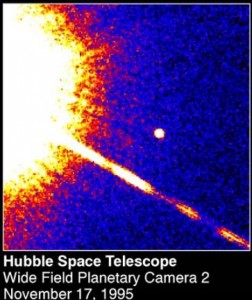Here’s a Gothic concept for you.
When small stars run out of fuel, they die a slow death. They give off a long-dying red glow for millions of years as they cool; this is called a “red dwarf.” Alternately, a would-be star is too small to ignite in the first place; this is called a “brown dwarf.” Both red dwarfs and brown dwarfs are far more massive than the largest planet, and so they have a powerful gravitational pull.
Here then, is the theory of Nemesis. Scientists have long observed that extinction events occur with significant regularity, approximately once every 27 million years. One theory of this wave of death is that our solar system is really a binary-star system. Our sun has a companion star, a small red or brown dwarf too small and dim to be detected from Earth. Like all binary systems, both stars rotate around a single focal point, but since the brown dwarf is so much smaller, its has a greater orbit, and probably one of great eccentricity. It disappears for millions of years at a time, and perhaps it never comes all that close to even distant planets. And yet, as it moves along its path, this rogue star throws comets and asteroids off of their conventional orbits, sending many of them into otherwise clear regions near the sun. This would result in the sort of impact events that disrupt the earth’s climate and atmospheric composition. This would result in a planetary extinction event a huge scale. This star, if it exists, is called “Nemesis.”
As it turns out, I haven’t thought about Nemesis in years, until recently a close examination of the fossil record has thrown significant doubt on Nemesis as a valid theory. The patterns are too regular; gravity is an interactive thing, and given the numbers of encounters Nemesis would have had over the long periods of time being examined, there would have been a different pattern to the extinction events than what has been observed.
This doesn’t change the idea that, as a hypothesis, that is, as an explanation for what might cause planetary extinction events, Nemesis is completely valid and profoundly Gothic. An invisible, unknown, unacknowledged object, ejected from planetary relevance makes a regular appearance, and that appearance is always accompanies by death. It is, in fact, a revisiting and validation of scripted portents in celestial events.
For all we know, if there is a better explanation, it is possibly Gothic as well.
